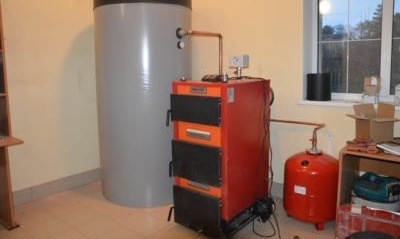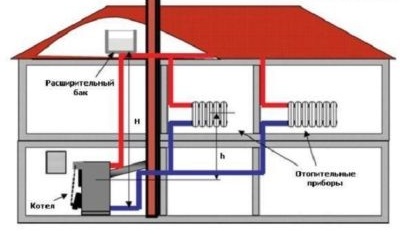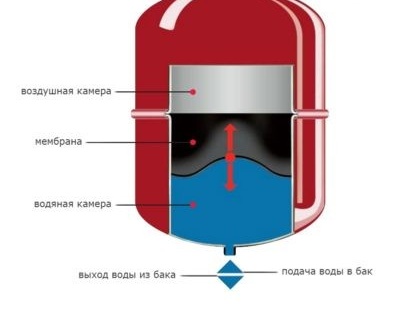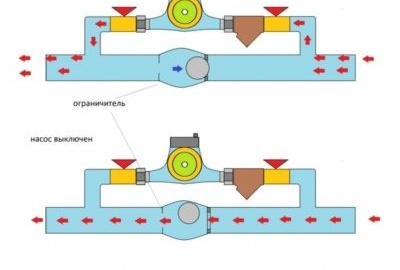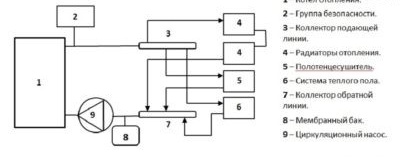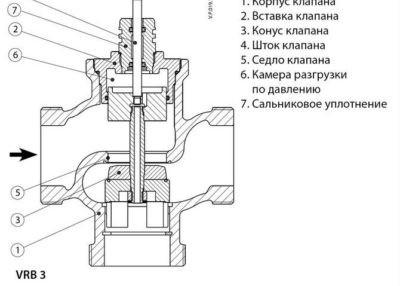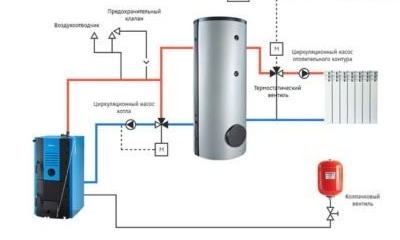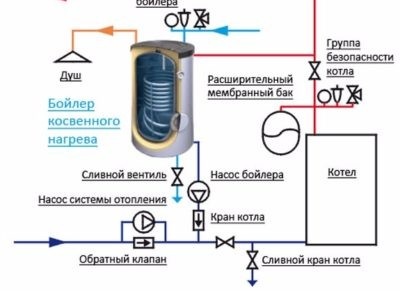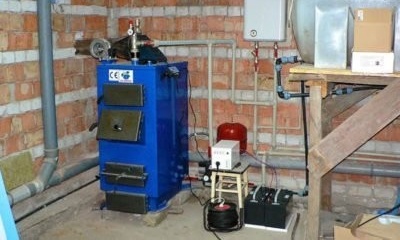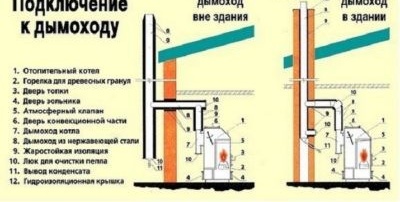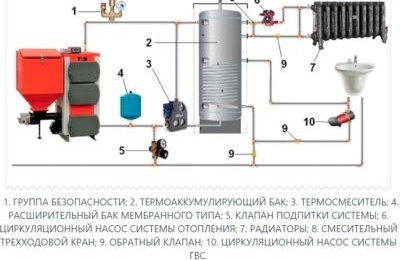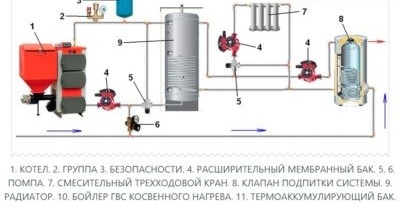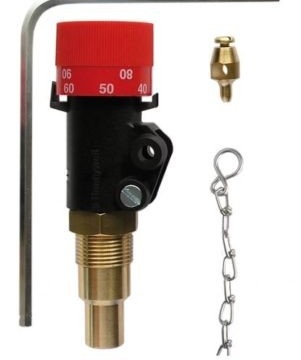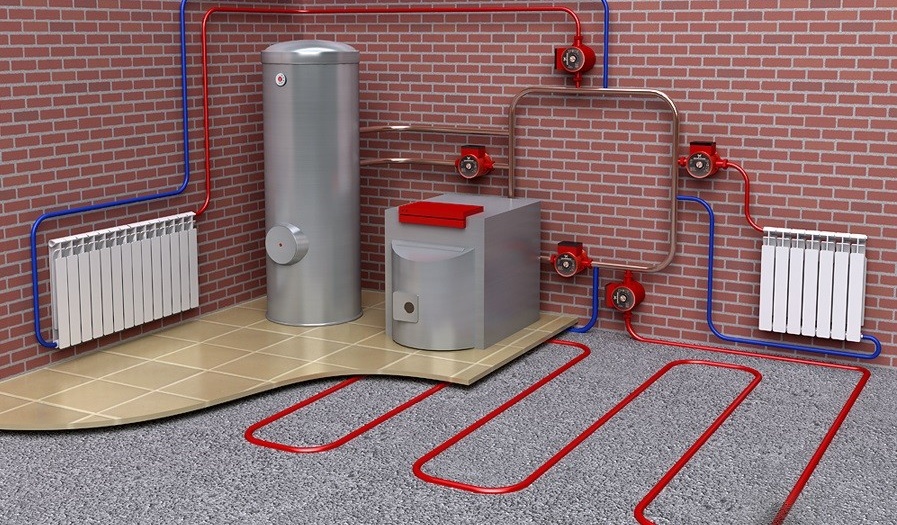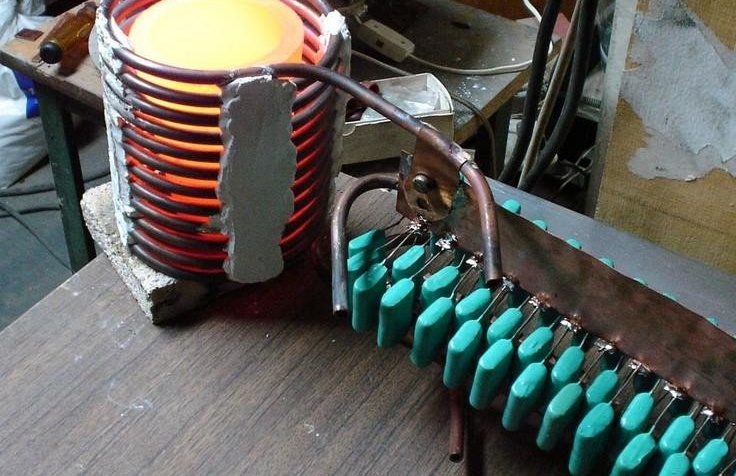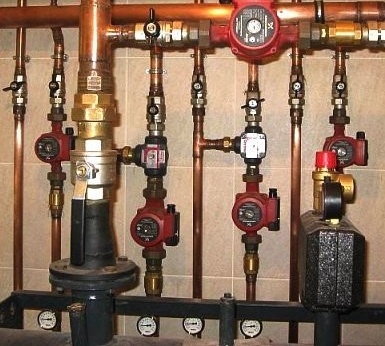We connect a solid fuel boiler to the heating system: problems and their solutions
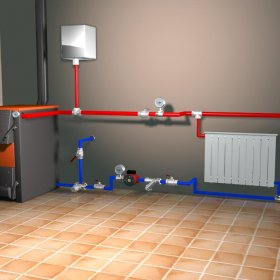
Unlike electric and gas heating units, solid fuel boilers are almost never equipped with circulation pumps, a safety group, and adjustment and control devices. Each solves these issues independently, choosing a heating device strapping scheme in accordance with the type and features of the heating system. Not only the efficiency and productivity of heating, but also its reliable, trouble-free operation depends on how correctly the heat generator is installed. That is why it is important to include nodes and devices in the circuit that will ensure the longevity of the heating unit and its protection in case of emergency.
In addition, when installing a solid fuel boiler, do not abandon equipment that creates additional convenience and comfort. Using a heat accumulator it is possible to solve the problem of temperature difference during the boiler reset, and the indirect heating boiler will provide the house with hot water. Have you thought about connecting a solid fuel heating unit in accordance with all the rules? We will help you with this!
Content
Typical solid fuel boiler piping schemes
The complexity of controlling the combustion process in solid fuel boilers leads to a large inertia of the heating system, which negatively affects the convenience and safety during operation. The situation is further complicated by the fact that the efficiency of units of this type directly depends on the temperature of the coolant. For efficient heating operation, the piping should provide a temperature of the thermal agent in the range of 60 - 65 ° С. Of course, if the equipment is improperly integrated, such heating at a positive temperature “overboard” will be very uncomfortable and uneconomical.In addition, the full operation of the heat generator depends on a number of additional factors - the type of heating system, the number of circuits, the presence of additional energy consumers, etc. The following strapping patterns take into account the most common cases. If none of them meets your requirements, then knowledge of the principles and features of the structure of heating systems will help in the development of an individual project.
Open type system with natural circulation in a private house
First of all, it should be noted that open systems of the gravitational type are considered the most suitable for solid fuel boilers. This is due to the fact that even in emergency cases associated with a sharp increase in temperature and pressure, the heating is likely to remain airtight and efficient. It is also important that the functionality of the heating equipment does not depend on the availability of power supply. Given that wood-fired boilers are installed not in megacities, but in areas remote from the benefits of civilization, this factor will not seem so insignificant to you. Of course, this scheme is not without drawbacks, the main of which are:
- free access of oxygen to the system, which causes internal corrosion of the pipes;
- the need to replenish the coolant level due to its evaporation;
- uneven temperature of the thermal agent at the beginning and at the end of each circuit.
A layer of any mineral oil 1 to 2 cm thick poured into the expansion tank will prevent oxygen from entering the coolant and reduce the rate of liquid evaporation.
Despite the shortcomings, the gravity circuit is very popular due to its simplicity, reliability and low cost.
When deciding to carry out installation in this way, note that for normal circulation of the coolant, the boiler inlet must be below the heating radiators by at least 0.5 m. The supply and return pipes must have slopes for normal circulation of the coolant. In addition, it is important to correctly calculate the hydrodynamic resistance of all branches of the system, and in the design process, try to reduce the number of shutoff and control valves. The correct operation of the system with natural coolant circulation also depends on the installation location of the expansion tank - it must be connected at the highest point.
Closed system with natural circulation
Reverse Installation expansion tank membrane type This will avoid the harmful effects of oxygen and eliminate the need to control the level of coolant.
When deciding to equip the gravity system with a sealed expansion tank, consider the following points:
- the capacity of the membrane tank must contain at least 10% of the total coolant volume;
- a safety valve must be installed on the feed pipe;
- the highest point of the system must be equipped with an air vent.
Additional devices that are part of the safety group of the boiler (safety valve and air vent) will have to be purchased separately - manufacturers rarely complete units with such devices.
The safety valve allows the coolant to be discharged if the pressure in the system exceeds a critical value. A normal working indicator is pressure from 1.5 to 2 atm. The emergency valve is set to 3 atm.
You will learn more about this system from our next article:https://aquatech.tomathouse.com/en/otoplenie/razvodka-otopitelnoj-sistemy/zakrytaya-sistema-otopleniya.html.
Features of systems with forced coolant movement
In order to equalize the temperature in all areas, a circulation pump is integrated into the closed heating system.Since this unit can provide forced movement of the coolant, the requirements for the level of installation of the boiler and compliance with slopes become negligible. Nevertheless, do not give up on the autonomy of natural heating. If you install a bypass branch at the outlet of the boiler, called bypass, then in the event of a power outage, the circulation of the heat agent will provide gravity.
An electric pump is installed on the return line, between the expansion tank and the inlet fitting. Due to the lowered temperature of the coolant, the pump operates in a more gentle mode, which increases its durability.
Circulation unit installation on the return it is also necessary for security purposes. If water boils in the boiler, steam may form, which, if it enters the centrifugal pump, is fraught with a complete cessation of fluid movement, which can lead to an accident. If the device is installed at the inlet to the heat generator, it will be able to provide circulation of the coolant even in case of emergency.
Connection via collectors
If several parallel branches with radiators, a warm water floor, etc. are required to be connected to a solid fuel boiler, balancing of the circuits is required, otherwise the coolant will go along the path of least resistance, and the rest of the system will remain cold. For this purpose, one or several collectors (comb) are installed at the outlet of the heating unit - distribution devices with one input and several outputs. The installation of the comb opens up great opportunities for connecting several circulation pumps, allows you to supply the heat agent with the same temperature to consumers and regulate its flow. The only drawback of this type of strapping is the complexity of the design and the increase in the cost of the heating system.
A separate case of collector strapping is a connection with a hydraulic arrow. Its difference from a conventional collector is that this device acts as a kind of intermediary between the heating boiler and consumers. Made in the form of a large-diameter pipe, the hydraulic arrow is installed vertically and connected to the inlet and pressure pipes of the boiler. At the same time, the inset of consumers is done at different heights, which allows you to choose the optimal temperature for each circuit.
Installation of emergency and regulatory systems
Alarm and control systems serve several purposes:
- system protection against depressurization in case of uncontrolled increase in pressure;
- temperature control of individual circuits;
- boiler overheating protection;
- prevention of condensation processes associated with a large difference in supply and return temperatures.
To solve the security problems of the system, a safety valve, an emergency heat exchanger or a natural circulation circuit are introduced into the strapping circuit. As for the issues of regulating the temperature of the thermal agent, thermostatic and controlled valves are used for these purposes.
3-way valve harness
A solid fuel boiler is a batch heating unit, therefore it is exposed to the risk of corrosion due to condensate that falls on its walls during heating. This is due to the ingress of too cold coolant from the return to the heat exchanger of the heating unit. The danger of this factor can be eliminated with the help of a three-way valve. This device is an adjustable valve with two inputs and one output.According to the signal from the temperature sensor, the three-way valve opens the channel for supplying hot coolant to the boiler inlet, preventing the dew point. As soon as the heating unit enters the operating mode, the fluid flow in a small circle stops.
A fairly common mistake is the installation of a centrifugal pump up to a three-way valve. Naturally, with the valve closed, there can be no talk of any fluid circulation in the system. It will install the pump correctly after the adjustment device.
The three-way valve can also be used to adjust the temperature of the heat agent entering the consumers. In this case, the device is configured to work in the opposite direction, mixing cold coolant from the return to the supply.
Buffer circuit
Low controllability of solid fuel boilers requires constant monitoring of the amount of firewood and traction, which significantly reduces the convenience of their operation. Loading more fuel and not worrying about the possible boiling of the liquid will allow the installation of a buffer tank (heat accumulator). This device is a sealed tank separating the heating unit from consumers. Due to its large volume, the buffer tank can accumulate excess heat and, if necessary, give it to radiators. The mixing unit, which uses the same three-way valve, will help adjust the temperature of the liquid coming from the heat accumulator.
Harness elements ensuring the safety of the heating system
In addition to the safety valve, which was mentioned above, the protection of the heating unit from overheating is solved by means of an emergency circuit, through which cold water is supplied to the heat exchanger from the water supply. Depending on the design of the boiler, the coolant can be supplied directly to the heat exchanger or a special coil installed in the working chamber of the unit. By the way, it is the latter option that is the only possible one for systems with antifreeze flooded. Water is supplied by a three-way valve, which is controlled by a sensor installed inside the heat exchanger. The discharge of "spent" fluid occurs through a special line connected to the sewer.
Scheme with indirect boiler connection
The piping with the boiler connection for hot water can be used for all types of heating systems. For this, a special heat-insulated tank (boiler) is connected to the water supply and hot water supply systems, and a coil is installed inside the water heater, which is inserted into the heat agent supply line. Passing along this circuit, the hot heat carrier transfers heat to the water. Often, indirect heating boilers are also equipped with heating elements, thanks to which it becomes possible to receive hot water in the warm season.
The three-way valve can also be used in the circuit of indirect boiler heating. Read more about this in our material:https://aquatech.tomathouse.com/en/otoplenie/kotelnaya/obvyazka-bojlera-kosvennogo-nagreva.html.
Video: Solid fuel boiler piping
Correct installation of a solid fuel boiler in a closed heating system
A huge advantage of solid fuel boilers is that no permits are required for their installation. Installation can be done with one's own hand, especially since this does not require any special tools or special knowledge. The main thing is to responsibly approach the work and follow the sequence of all stages.
Boiler room equipment
The disadvantage of the heating units used for burning wood and coal is the need for a special, well-ventilated room.Of course, it would be possible to install the boiler in the kitchen or bathroom, however, the periodic emission of smoke and soot, dirt from fuel and combustion products make this venture unsuitable for implementation. In addition, the installation of burning equipment in living rooms is also unsafe - the release of off-gas can lead to tragedy.
When installing a heat generator in a boiler room, several rules are observed:
- the distance from the furnace door to the wall should be at least 1 m;
- at a distance of not higher than 50 cm from the floor and not lower than 40 cm from the ceiling, ventilation ducts must be installed;
- the room should not contain combustible-lubricating and flammable substances and objects;
- the base area in front of the ashpit is protected with a metal sheet with dimensions of at least 0.5x0.7 m.
In addition, an opening under the chimney is provided at the installation site of the boiler, which is led out. Manufacturers indicate the configuration and dimensions of the chimney in the technical passport, so you will not need to invent anything. Of course, if the need arises, then you can deviate from the documentation requirements, however, in any case, the channel for the removal of combustion products should provide excellent traction in any weather.
When installing a chimney, all joints and gaps are sealed with sealing materials, and also provide windows for cleaning the channels of soot and a trap for condensate.
Preparing to install a heating unit
Before installing the boiler, a piping scheme is chosen, the length and diameter of the pipelines, the number of radiators, the type and number of additional equipment and shut-off and control valves are calculated.
Despite all the variety of design solutions, experts recommend choosing a combination heating system that can provide forced and natural coolant circulation. Therefore, when calculating, it is necessary to consider how a parallel section of the supply pipeline (bypass) with a centrifugal pump will be installed and the slopes necessary for the operation of the gravitational system to be provided. Do not refuse and buffer capacity. Of course, installing it will incur additional costs. Nevertheless, a drive of this type will be able to align the temperature curve, and one bookmark of fuel is enough for a longer time.
The heat accumulator with an additional circuit, which is used for hot water supply, will provide special comfort. Given the fact that due to the installation of a solid fuel unit in a separate room, the length of the DHW circuit increases significantly, an additional circulation pump is mounted on it. This will eliminate the need to drain the cold water while waiting for the hot to go.
Before mounting the boiler, a place must be provided for expansion tank and do not forget about devices designed to reduce system pressure in critical situations. A simple strapping scheme that can be used as a working draft is shown in our figure. It combines all the equipment discussed above and ensures its correct and trouble-free operation.
You will learn even more information about the arrangement of the boiler room and the installation of equipment from our article:https://aquatech.tomathouse.com/en/otoplenie/kotelnaya/kotelnaya-v-chastnom-dome.html.
Installation and connection of solid fuel heat generator
After all the necessary calculations and preparation of equipment and materials, they begin installation.
- They are installed in place, leveled and the heating unit is mounted, after which a chimney is connected to it.
- Mount radiators, install a heat accumulator and an expansion tank.
- Mount the supply pipe and bypass, on which the centrifugal pump is installed. In both sections (direct and bypass), ball valves are installed so that the coolant can be transported by forced or natural means.
We remind you that a centrifugal pump can only be installed with the correct orientation of the shaft, which should be in a horizontal plane. The manufacturer indicates the diagrams of all possible mounting options in the product instructions.
- The pressure line is connected to a heat accumulator. I must say that the inlet and outlet pipes of the buffer tank must be installed in its upper part. Due to this, the amount of warm water in the tank will not affect the availability of the heating circuit. Be sure to note the fact that cooling the boiler during the reboot period will lower the temperature in the system. This is due to the fact that at this time the heat generator will work as an air heat exchanger, transferring heat from the heating system to the chimney. To eliminate this defect, separate circulation pumps are installed in the boiler and heating circuit. By placing a thermocouple in the combustion zone, it is possible to stop the movement of the coolant through the boiler circuit when the fire is extinguished.
- A safety valve and an air vent are installed on the supply line.
- Connect the emergency circuit of the boiler or install shut-off and control valves, which when boiling water will open its discharge line into the sewer and the cold fluid supply channel from the water supply.
- Mount the return pipe from the heat accumulator to the heating unit. A circulation pump, a three-way valve and a filter settler are installed in front of the boiler inlet pipe.
- Separately, an expansion tank is mounted on the return pipe.
Note! On pipelines that are connected to protection devices, shutoff valves are not installed. In these areas there should be as few connections as possible.
- The upper outlet of the heat storage tank is connected to a three-way valve and a circulation pump for the heating circuit, after which radiators are connected and the return pipe is mounted.
- After connecting the main circuits, they begin to equip the hot water supply system. If the coil of the heat exchanger is built into the buffer tank, then it will be enough just to connect the inlet for cold water and the outlet to the “hot” line to the corresponding nozzles. When installing a separate indirect heating water heater, use a circuit with an additional circulation pump or a three-way valve. In both cases, a check valve is installed at the inlet of the cold water supply. He will block the path for the heated liquid into the "cold" water supply.
- Some solid fuel boilers are equipped with a draft regulator, the work of which is to reduce the flow area of the blower. Due to this, the air flow to the combustion zone decreases and its intensity, and, accordingly, the temperature of the coolant, decreases. If the heating unit has this design, then mount and adjust the actuator of the air damper mechanism.
All threaded joints must be carefully sealed with sanitary flax and special non-drying paste.
After the installation is completed, the coolant is poured into the system, centrifugal pumps are turned on at full power and carefully inspect the places of all connections for leakage. After making sure that there are no leaks, they light the boiler and check the operation of all circuits at maximum conditions.
Features of the integration of a solid fuel unit into an open heating system
The main feature of open heating systems is the contact of the coolant with atmospheric air, which occurs with the participation of the expansion tank. This capacity is designed to compensate for the thermal expansion of the coolant that occurs when it is heated. The expander is injected at the highest point in the system, and in order to prevent hot fluid from overflowing the room when the tank is full, a drain pipe is connected to its upper part, the second end of which is discharged into the sewer.
The large volume of the tank forces it to be installed in the attic, therefore, additional warming of the expander and pipes that are suitable for it will be necessary, otherwise they may freeze in the winter. In addition, it must be remembered that this element is part of the heating system, so its heat loss will entail a decrease in temperature in the radiators.
Since the open system is not hermetic, there is no need to install a safety valve and connect emergency circuits. When the coolant boils, the pressure will be released through the expansion tank.
Special attention should be given to pipelines. Since the water in them will flow by gravity, the diameter of the pipes and the hydraulic resistance in the system will influence the circulation. The last factor depends on turns, contractions, level drops, etc., so their number should be minimal. In order to initially give the flow of water the necessary potential energy, a vertical riser is mounted at the outlet of the boiler. The higher the water can rise along it, the higher the coolant speed will be and the faster the radiators will warm up. For the same purpose, the return duct should be at the lowest point of the heating system.
In conclusion, I would like to note that in open systems it is preferable to use not antifreeze, but water. This is due to higher viscosity, reduced heat capacity and rapid aging of the substance in contact with air. As for water, it is best to soften and, if possible, never drain. This will increase the service life of pipelines, radiators, heat generator and other heating equipment by several times.
Pay attention to the article on choosing coolants for heating systems:https://aquatech.tomathouse.com/en/otoplenie/radiatory/teplonositel-dlya-sistem-otopleniya.html.
Video: DIY solid fuel boiler connection
As you can see, the choice of the boiler integration scheme depends on many factors, including the features of the heating system and the need to install additional equipment. If you have successfully figured out all the nuances, then you can safely get to work. Finally, I would like to note that heating is one of the most complex and critical engineering systems. If you do not have self-confidence, do not experiment. Remember that installation errors will sooner or later result in serious problems, so do not hesitate to ask experts for advice.
